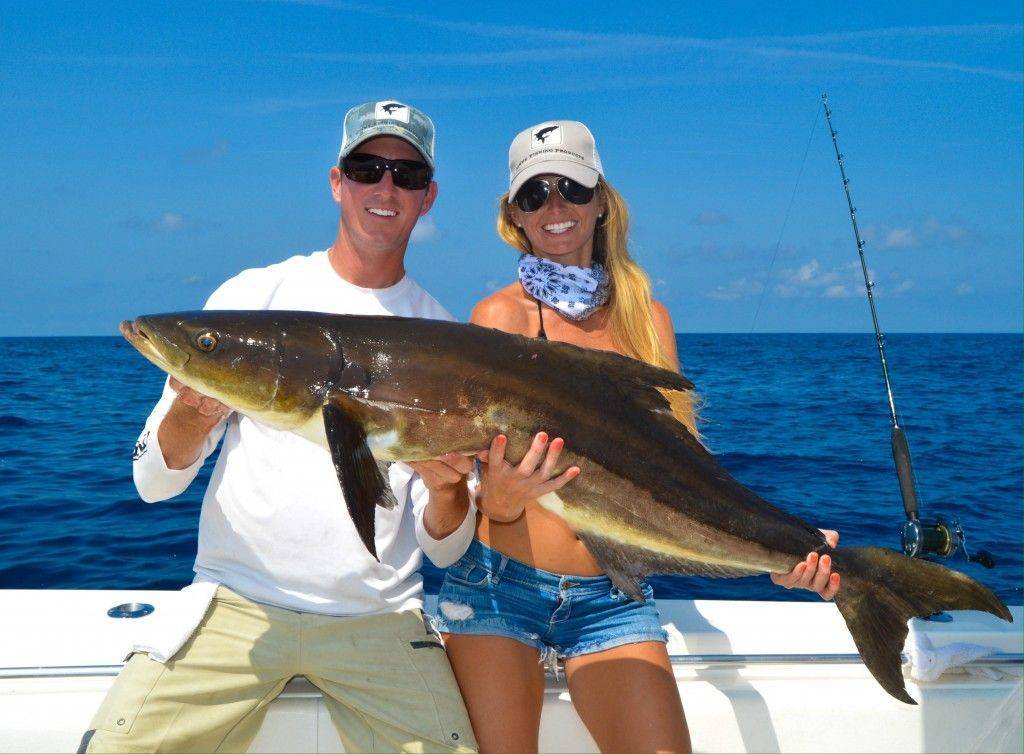Cobia is my favorite fish to pursue. I’m devoted to cobia fishing so much, I named my dog Cobia. Fishing for these awesome fish is a mixture of fishing and hunting. The fishing is dynamic. The lows are long periods of nothingness or heartbreak break-offs, and the best high is in the anticipation. It is a combination of all things, whether preparing the tackle and boat for the expected happening, gathering quality bait, the travel to the hot spot, then the other hot spots, perhaps sighting the fish, delivering the bait well, the take, the challenge against a possible large and formidable game fish, the crew coming as one in harmony and synchronicity trying to boat the cobia with the angler, then heaving the cobia over the gunnels for a climax celebration. Every aspect is great! So whether or not you end up with the low or the high; it is very satisfying fishing.
Cobia, also known as, ling, lemon fish, crab-eater, black kingfish and black salmon, are an unusual fish. That is what makes them special. They are the sole representatives of the family rachycentridae. From the Greek, it means ‘spine/sting’ based on the six-nine forward spiny dorsal fins that can rake the blood out of you trying to work with a fish-gone-wild once boated.
Cobia is cosmopolitan in warm temperate to tropical waters. They tolerate a wide temperature (eurythermal), 35-90 degrees F and salinity range (euryhaline), 5-44.5 parts per thousand (ppt) respectively. Yet cobia do prefer warmer water between 70 and 85 Fahrenheit, these fish aren’t prone to cold shock such as might occur in the early spring or late fall. In terms of salinity, average seawater is 35 ppt, meaning a flush of freshwater that causes salinity drop, isn’t going to push them offshore soon. However, prolonged exposure to lower salinities will motivate them away from shore.
They spawn in offshore aggregations from April through September. The female can spawn up to 30 times per season. She releases tiny buoyant eggs that become part of the plankton for one week or slightly more, before development.
In the Forgotten Coast and Big Bend areas, cobia are pelagic, meaning they live in open waters and come our way when conditions are conducive during late spring through late fall. Generally, they become more solitary as they mature. However, smaller cobia may assemble together around submerged structure, such as high rocks, wrecks, channel markers, etc. Larger cobia may associate, but are not part of the smaller fish assemblage.
The maximum size of cobia is estimated at 78 inches (6.5 feet) and 150 pounds. The world record cobia was caught at Shark Bay, Australia weighing 135 pounds. The average cobia landed in the Florida panhandle is between 15 to 30 pounds. The best baits vary upon each encounter, as cobia can be fickle. Nonetheless, frisky live baits (fresh blue runners or pinfish), or a whole squid tossed out amongst some miscellaneous chum chunks, or jigs worked lively can by your ticket to catching a cobe. Good luck!

